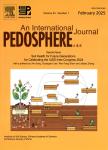Assessing Reclamation Levels of Coastal Saline Lands with Integrated Stepwise Discriminant Analysis and Laboratory Hyperspectral Data
Assessing Reclamation Levels of Coastal Saline Lands with Integrated Stepwise Discriminant Analysis and Laboratory Hyperspectral Data作者机构:Institute of Agricultural Remote Sensing and Information System Zhejiang University Hangzhou 310029 (China). State Key Laboratory of Remote Sensing Science Institute of Remote Sensing Application Chinese Academy of Sciences Beijing 100101 (China)
出 版 物:《Pedosphere》 (土壤圈(英文版))
年 卷 期:2006年第16卷第2期
页 面:154-160页
核心收录:
学科分类:082802[工学-农业水土工程] 08[工学] 0828[工学-农业工程]
基 金:Project supported by the German Federal Ministry for Research and Education Germany (No. AZ39742)the National Natural Science Foundation of China (No. 40571066)
主 题:hyperspectra reclamation remote sensing saline soil SDA
摘 要:At different times over the past 30 years in Zhejiang Province, China, the coastal tidelands have been successively enclosed and reclaimed for agricultural land use. The purpose of this work was to evaluate whether laboratory hyperspectral data might be used to estimate the physicochemical characteristics of these reclaimed saline soils. A coastal region of Shangyu City (Zhejiang Province), which was grouped into four subzones according to reclamation history, was used as the study area, and soil samples were collected in each subzone. Physicochemical analyses showed that the soils were characterized by high electrical conductivity and sand content with low organic matter; the longer the saline lands had been reclaimed, the lower were the electrical conductivity and sand content and the higher the organic matter content. These changing trends of soil chemical and physical properties were found in laboratory reflectance spectra of soil samples and their first-order derivative curves. Stepwise discriminant analysis (SDA) identified six salient spectral bands at 488, 530, 670, 880, 1400, and 1900 nm. Using derived discriminant functions for saline lands with different historical years of reclamation, classification revealed an overall accuracy from a self-test of 86.6% and from cross-validation of 89.3%. Therefore, as opposed to time-consuming field investigations, this study suggested that remotely sensed hyperspectral data could serve as a promising measure to assess the reclamation levels of coastal saline lands.




